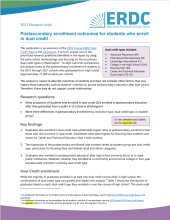This publication is an extension of the 2023 Annual ERDC Dual Credit Report and Dashboard. It aims to answer one of the prioritized research questions identified in the report by using the same cohort methodology and focusing on the six primary dual credit types in Washington. To align outcome comparisons, this analysis looks at the postsecondary enrollment of students in the 2015 through 2021 cohorts who graduated from high school (approximately 71,000 students per cohort). This analysis is meant to describe outcomes of students and does not consider other factors that may impact those outcomes, such as students’ intention to pursue postsecondary education after high school. Therefore, these data do not support causal relationships.
Research Questions:
- What proportion of students who enrolled in dual credit (DC) enrolled in postsecondary education after they graduated from a public K-12 school in Washington?
- Were there differences in postsecondary enrollment by institution type, dual credit type, or student group?
Key findings include:
- Graduates who enrolled in dual credit had substantially higher rates of postsecondary enrollment than those who did not enroll in dual credit. Enrollment rates were highest for Running Start students and lowest for Career and Technical Education-Dual Credit students.
- The magnitude of the postsecondary enrollment rate increase varied by student group and dual credit type, particularly for Running Start and federal racial and ethnic categories.
- Graduates who enrolled in postsecondary education after high school primarily did so at in-state public institutions. However, whether they enrolled at a community and technical college or four-year baccalaureate institution varied by dual credit type.
To view detailed result tables, see the Appendix file.


